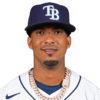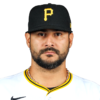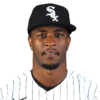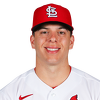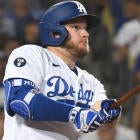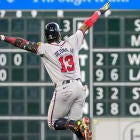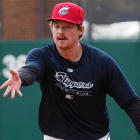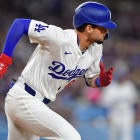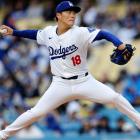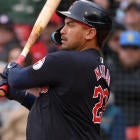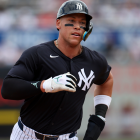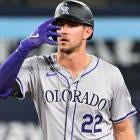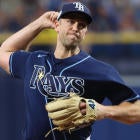
Fantasy Baseball is a diverse game with multiples styles of play, each deserving of thoughtful analysis and uniquely tailored player assessments.
But for reasons of practicality, those player assessments too often become either overly narrow, treating one format as the only format, or overly broad, treating all formats as one and the same.
The goal here is to highlight the differences between two of the most disparate formats and identify some of the players most susceptible to the distinction.
First, though, let's make sure we have our terminology straight, because it's a bit of a quagmire. When I refer to a Rotisserie league, I mean any that uses category-based 5x5 scoring. Some Head-to-Head leagues also do, particularly on sites like Yahoo, and so if you play in such a league, understand that the All-Roto team is the one that applies to you.
When I refer to a Head-to-Head league, on the other hand, I mean any that uses points-based Fantasy Football-style scoring, as is most popular here at CBS Sports. If you play in a points league that isn't technically Head-to-Head, understand that the All-H2H team is still the one that applies to you.
More accurately, these teams could be described as the All-Categories and All-Points teams, but alas, All-Roto and All-H2H is better branding. And it's all about the branding, baby.
Please note that these aren't intended to be the best possible lineups you could construct in these formats, which is why Aaron Judge is depicted in neither. They're merely the most representative of each format, comprised of the players you might go out of your way to draft specifically because you play in said format.
All-H2H team
Based on standard CBS Sports scoring:
| Head-to-Head point values | ||||||||
| For hitters | | For pitchers | | |||||
Single | 1 | Walk | -1 | |||||
Double | 2 | Earned run | -1 | |||||
Triple | 3 | Hit | -1 | |||||
Walk | 1 | Hit batter | -1 | |||||
Caught stealing | -1 | Inning | 3 | |||||
Hit by pitch | 1 | Strikeout | 0.5 | |||||
Home run | 4 | Win | 7 | |||||
Strikeout | -0.5 | Loss | -5 | |||||
Run | 1 | Save | 7 | |||||
RBI | 1 | QS | 3 | |||||
Stolen base | 2 | | | |||||
This format is the more straightforward one. There's no need to balance categories. Virtually everything a player produces is of benefit to you, and the benefit isn't relative to what you already have. What makes it complicated is that you have to consider the full scope of a player's contributions rather than just the handful that matter to Rotisserie leagues. More overlooked stats like doubles, walks and strikeouts can be real differentiators for hitters. Pitchers often stand out simply by accumulating innings. In fact, pure accumulation is a big part of the Head-to-Head points equation since percentage stats like batting average, ERA and WHIP have no direct value.
Catcher
Alejandro Kirk may seem like the more obvious choice since his strikeout rate is so low, but in the format that most rewards volume, a true everyday catcher like Adley Rutschman stands out all the more. He likewise earns high marks for plate discipline, his 13.8 percent walk rate ranking No. 1 at the position, and even if he doesn't take a step forward power-wise in Year 2, his 50-doubles pace will still count for something here.
Honorable mention: Alejandro Kirk, TOR
First base
The proof is in the pudding for Anthony Rizzo, whose 3.17 points per game last year were more than Matt Olson had, placing him behind only Paul Goldschmidt, Freddie Freeman, Pete Alonso and Vladimir Guerrero at the position. Rizzo is more of an afterthought in Rotisserie leagues, presumably because of his .224 batting average, but as long he keeps the home runs high and the strikeouts low, the points will be there.
Honorable mention: Josh Bell, CLE
Second base
As with Rizzo at first base, Max Muncy's biggest shortcoming is his batting average, which generally isn't as low as the .199 mark he delivered last year but is likely to fall in the .240-.260 range. A walk is genuinely as good as a hit in points leagues, though, and Muncy delivers nearly as many of the former as the latter year after year (coming within one last year). And because a disproportionate number of his hits are of the four-base variety, his best-case outcome could put him on near equal footing with Jose Altuve at this position.
Honorable mention: Jake Cronenworth, SD
Third base
Alex Bregman is among the players whose power has suffered the most with the elimination of the juiced ball, but his plate discipline remains God-tier, such that he actually averaged more points per game last year (3.19) than Austin Riley (3.16). That's not to say he should be drafted ahead of Riley in this format, but it is to say that having more walks than strikeouts, as Bregman and seven others did last year, makes for an especially high floor.
Honorable mention: Nolan Arenado, STL
Shortstop
Have you picked up on a theme yet? Every one of these players either walks a lot or strikes out a little (if not both). Wander Franco fits into the latter category, having struck out only 10.7 percent of the time in his brief career. His substandard exit velocity readings have some fearing he'll never deliver the requisite power to set himself apart in Rotisserie leagues, which is premature to say given his 21 years of age and top prospect pedigree. But he's fine just the way he is in points leagues.
Honorable mention: Xander Bogaerts, SD
Outfield
While Juan Soto had Rotisserie players pulling out their hair last year, his batting average coming in 80 points lower than the previous two years, Head-to-Head players hardly had reason to notice. You know how I said having more walks than strikeouts makes for an especially high floor? Well, Soto had roughly 40 more walks than strikeouts -- has two years in a row, in fact -- which makes him an easy top-five pick in this format.
At least in real life, a home run is the most valuable contribution a hitter can make, but by failing to weigh it properly, instead putting it on equal footing with four lesser hitter stats, 5x5 leagues have never fully appreciated the value of a player like George Springer. A steady slugger who also has pretty good plate discipline, Springer averaged more Head-to-Head points per game than Kyle Tucker last year. Meanwhile, Steven Kwan makes up for his lack of power in this format simply by not losing points on strikeouts. He averaged more points per game than Randy Arozarena.
Honorable mention: Brandon Nimmo, NYM
Starting pitcher
The name of the game here, even more so than for hitters, is volume. You want a pitcher who goes deep, not only because it gives him a better chance of securing the most valuable pitching stat, a win, but also because innings themselves are worth three points apiece. Sandy Alcantara is a clear outlier in that regard and the No. 1 choice among pitchers as a result. Not only were his six complete games twice as many as anyone else, but half of his starts went more than seven innings. Framber Valdez is probably second in terms of workload expectations, albeit a distant second.
Those two fall short of their peers in strikeouts, which are worth only half a point in this format. Strikeouts still matter when assessing pitchers, but less for their direct worth than what they say about overall skill level. By pitching more to contact, the back four on this list are susceptible to a higher WHIP -- especially Martin Perez, whose walk rate is high for someone who throws so many innings -- but that's another stat with no direct consequence in this format. If you throw more innings, it'll make up for allowing more baserunners or even an extra run, provided it doesn't cost you the win.
Relief pitcher
A starting pitcher who qualifies at relief pitcher is golden in points leagues (for the volume, of course), and you won't find much better than Spencer Strider. His dual eligibility is wasted in Rotisserie leagues, which typically don't distinguish between starting and relief pitchers for purposes of setting a lineup. Kenley Jansen, meanwhile, is in position to pile up a massive number of saves, but possibly with an ERA on the wrong side of 3.00. You'd like for your closers to help with your ratios in 5x5 leagues, but in this format, the points from the saves are all that matters.
All-Roto team
Based on standard 5x5 categories (BA, HR, RBI, R, SB for hitters and W, ERA, K, WHIP, SV for pitchers)
Rotisserie leagues aren't simply an exercise in collecting the best, most productive players. You have to weigh what each contributes across several categories and then strike the right balance across your entire roster. It's a quirk that leads to artificial scarcities, elevating a stat like stolen bases beyond its real-life utility. Efficiency is of greater concern, particularly on the pitching side, where 40 percent of what's scored is ERA and WHIP -- two stats with no direct value in Head-to-Head points leagues. Volume can actually be a detriment, then, if it negatively impacts those ratios.
Catcher
Daulton Varsho is one of only two catchers (the other being consensus No. 1 J.T. Realmuto) who'll be of real help in stolen bases, which is widely considered the scarcest of the five hitter categories. There's some speculation as to whether it will remain so with the new rule changes taking effect this year, but we can be certain catchers won't be running wild. While Will Smith and Adley Rutschman may have outperformed Varsho by Head-to-Head points per game last year, he's the preferred choice in this format.
Honorable mention: Salvador Perez, KC
First base
Hitters with the capacity for 30 homers and a .300 batting average are getting harder to find in a post-juiced ball world, and Nate Lowe's first-rate production in both categories last year made him the 57th-best player in this scoring format. It'll be hard for him to top what he did then, and yet, looking at it from a Head-to-Head perspective, his point-per-game average was worse than Rhys Hoskins' and about the same as Josh Bell's. The problem is he doesn't walk like a typical first baseman, but that's not an issue in this format.
Honorable mention: Ryan Mountcastle, BAL
Second base
Looks like Tommy Edman is a standout contributor in stolen bases and ... basically nothing else. So of course he's going to appeal to Rotisserie players in a way he doesn't to Head-to-Head. He meets a specific need. Throw all of his contributions into a single box, which is how points scoring works, and ... well, he's still pretty valuable. But he's more of a background player than one you deliberately target.
Honorable mention: Gleyber Torres, NYY
Third base
Bobby Witt's 20 homers and 30 steals as a rookie have him being valued like a Rotisserie stud already, even pushing him into Round 1 in some higher-profile contests. But his uninspiring .294 OBP and .722 OPS have more sway Head-to-Head points leagues, which account for a wider variety of contributions. By points per game, he was on near equal footing with Dansby Swanson, Xander Bogaerts and Willy Adames last year -- who are all shortstops, yes, but you get the idea. Nowhere near first-rounders.
Honorable mention: Ke'Bryan Hayes, PIT
Shortstop
It's not that Anderson is a bad option for points leagues, but he's just another face in a deep tier of mid-round shortstops, his most distinguishing characteristic being that he's more injury-prone. In 5x5 leagues, he's a potential lifesaver in batting average, and because he's also a relevant contributor in stolen bases, there are few comparables in the format where those two stats matter most.
Honorable mention: Jeremy Pena, HOU
Outfielder
Not surprisingly, these players (including honorable mention Randy Arozarena) are all big contributors in stolen bases, which are nice to have in a points league but downright essential in 5x5 play. Also not surprisingly, these players aren't so big on walks, which have no bearing on Rotisserie value other than increasing run-scoring and stolen base opportunities. It's like an entire tier of separation between the two formats. In the one, they're drafted more on the level of Kyle Schwarber. In the other, more on the level of Eloy Jimenez.
Honorable mention: Randy Arozarena, TB
Starting pitcher
This crop of pitchers excels in precisely the opposite way from the Head-to-Head crop. They're likely to overwhelm on an inning-per-inning basis, but the innings themselves are in question. Tyler Glasnow is the poster child with his 2.75 ERA, 0.97 WHIP and 12.7 K/9 over the past four years, but he has never thrown even 120 innings in a season and is still newly recovered from Tommy John surgery.
Tony Gonsolin looks like an ERA standout but likewise hasn't proven he can hold up to a full-season workload. Blake Snell should pile up strikeouts but often struggles to go deep into games. Jeffrey Springs had stellar ratios last year but was at times handled more like a long reliever even in games that he started. Cristian Javier has the best chance of breaking through with true ace production, but a high strikeout total and low WHIP -- two traits valued more in 5x5 leagues -- should be there even if he falls a little short with the workload.
Relief pitcher
A reliever's points-league value is tied almost directly to his saves total, which means the ratio darlings who aren't full-time closers hardly even matter. In this format, though, someone like Ryan Helsley can split saves with Giovanny Gallegos and still be the No. 2 overall reliever because his ratios are so good (not that I'm predicting he'll be No. 2 again). Trendy closer-in-waiting pick Andres Munoz, meanwhile, will have value in a 5x5 league even if he doesn't fully overtake Paul Sewald for saves.















